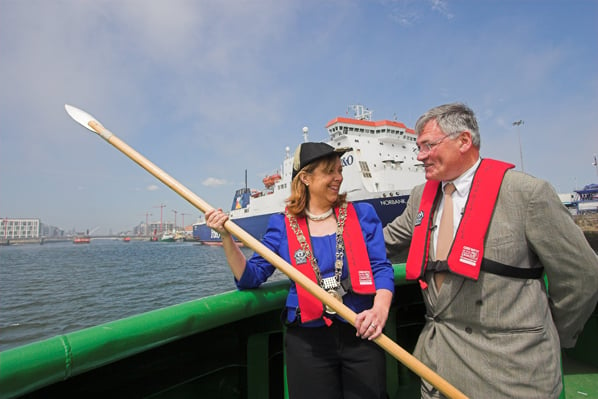The Lord Mayor of Dublin and Admiral of Dublin Port, Cllr. Emer Costello, today performed the 522 year old "Casting of the Spear" ceremony at Dublin Port.
The "Casting of the Spear" dates as far back as 1488 when the then Lord Mayor, Thomas Mayler set out on his horse to ride the city's boundaries. Historical records show that he rode out onto the strand as far as a man might ride and from there he cast a spear into the sea. At that time, casting the spear demonstrated the extent of the city boundaries eastwards. From that day onwards each year the Lord Mayor of Dublin re-enacts this medieval ceremony.
The ceremony was re-enacted this morning when the Lord Mayor travelled out into Dublin Bay onboard a Dublin Port tug boat and launched a spear deep into Dublin Bay's cold waters, and once again marked the position of the city boundaries eastwards.
Dublin Port, as an organisation, has a long and remarkable history also, dating back over 300 years. There have been many famous moments and famous visitors in that time.

Captain William Bligh (of "Mutiny on the Bounty" fame) has left a lasting legacy on the port and city. Bligh conducted a study of the tidal flows in Dublin Bay, which led to the construction of the Great South Wall. This construction has resulted in the formation of the present Bull Island, which did not exist in 1800. This amenity is now home to among other amenities two golf courses and an internationally renowned bird sanctuary.
Another interesting historical link with Dublin Port is the tale of the 'Ouzel Galley', an Irish merchant ship that set sail from Dublin Port in 1695. After failing to return for three years it was presumed lost at sea. In 1698 a panel comprising the city's most eminent merchants was set up to settle the question of insurance. The panel's ruling was that the ship had indeed been lost and that its owners and insurers should receive their due compensation. The galley's complement of thirty-seven crew and three officers were declared dead and the insurance was paid out.
However, after a further two years had elapsed, she mysteriously reappeared with her full complement of crew and a valuable cargo of spices and exotic goods. By this stage the insurance had been paid out on the in some cases the 'widows' of the sailors 'lost' at sea had remarried!
Speaking at the ceremony to mark the tradition of 'Casting the Spear' Lord Mayor of Dublin and Admiral of its Port, Cllr. Emer Costello, said: "It's a tremendous honour, as admiral of Dublin Port, to take part in such a treasured, time-honoured local tradition. Over the course of the last 500 years, Dublin Port has played an instrumental role in the development of our capital city. Having Ireland's biggest port so close to the city, in the heart of our capital, adds a great competitive advantage. As a gateway to European and international markets, Dublin Port continues to play a central role in supporting the country's return to economic growth".
Responding to the Admiral of the Port, Dublin Port Company Chief Executive Mr. Enda Connellan said: "Dublin Port is immensely proud of its heritage, its long links with the City and the contribution it has played in the life of this city and country. This ceremony reminds us of where Ireland's largest city has come from over the last 500 years and how the port has played its role in its development, facilitating €35 billion of trade per year and supporting 4,000 real jobs."

























